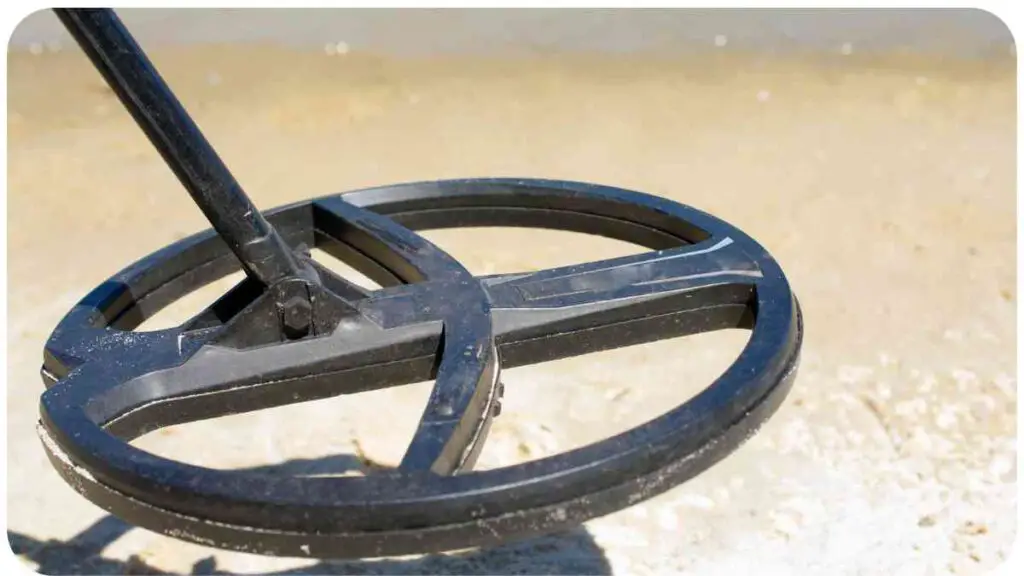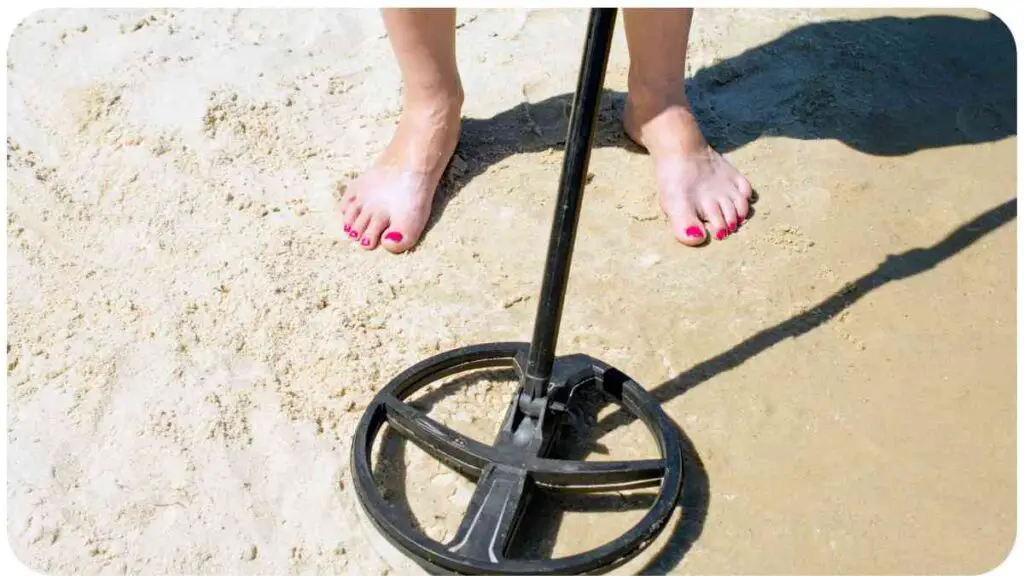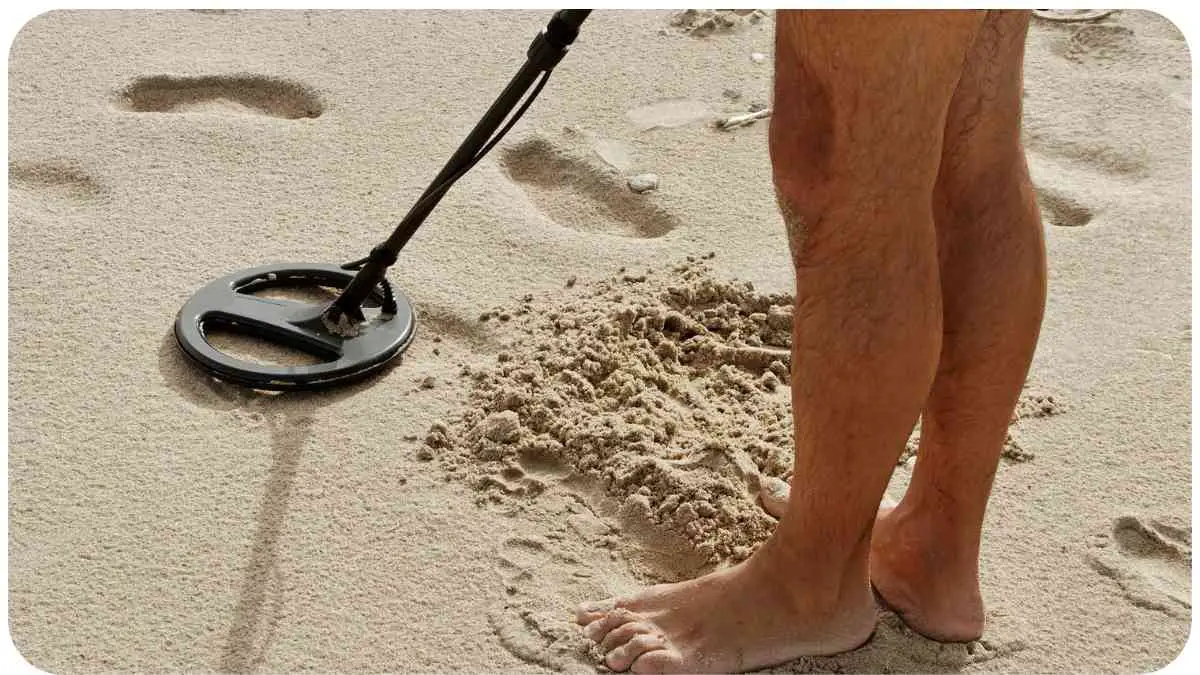Welcome to our comprehensive guide on troubleshooting a faulty metal detector. If you’re an avid treasure hunter or a professional in the field, you know how frustrating it can be when your trusty metal detector malfunctions.
In this article, we will provide you with expert advice and practical solutions to overcome common issues that arise with metal detectors. We’ll delve into the various components of metal detectors, explain their functioning, and address troubleshooting techniques to help you get back to detecting the precious metals and artifacts you love.
| Key Takeaways |
|---|
| Familiarize yourself with common metal detector issues |
| Inspect the coil cable for damage or loose connections |
| Verify control box settings and connections |
| Adjust sensitivity and ground balance settings appropriately |
| Avoid sources of electromagnetic interference |
| Ensure proper waterproofing for underwater use |
| Handle the detector with care to prevent physical damage |
| Stay updated with firmware and software |
| Consult the manufacturer or seek professional assistance when needed |
Understanding Metal Detectors
Before we dive into troubleshooting tips, it’s essential to have a basic understanding of how metal detectors work. Metal detectors consist of several key components, including a control box, a search coil, and a shaft.
The control box houses the electronic circuitry, battery, and controls, allowing you to customize settings such as sensitivity and discrimination. The search coil, also known as the coil or the head, emits electromagnetic fields and receives signals back from the metal objects beneath the ground. The shaft provides stability and allows you to adjust the height of the search coil for comfortable use.
Encountering issues with your Garrett AT MAX? Dive into these Troubleshooting Tips for Your Garrett AT MAX Metal Detector to enhance your treasure hunting experience. Equip yourself with the know-how to combat common problems.
Common Issues with Metal Detectors

Metal detectors, like any electronic device, can encounter various issues that affect their performance.
Some common issues you might face include power problems, false signals, coil malfunctions, display and control malfunctions, audio problems, ground balancing issues, target ID errors, calibration problems, sensitivity and depth troubles, electromagnetic interference (EMI), water damage, connecting issues, programming and firmware glitches, physical damage, and general maintenance and care.
Let’s explore each of these issues in detail and provide practical troubleshooting tips to resolve them effectively.
Troubleshooting Tips for Metal Detectors
Power Issues
Table: Common Power Issues
| Issue | Possible Cause | Troubleshooting Tips |
| Not turning on | Dead batteries or faulty power source | – Replace batteries with fresh ones<br>- Check power source connections |
| Random shutdowns | Intermittent power supply | – Ensure batteries are securely installed<br>- Use stable power sources |
| Display not functioning | Power supply or control board issues | – Verify battery connections<br>- Consult manufacturer or professional assistance |
Power issues can be frustrating and commonly occur when batteries are depleted or not connected correctly. Always begin troubleshooting by checking the batteries or power supply.
Minelab Equinox 800 is a reliable detector, but like any tool, it can have its quirks. Don’t let minor issues hamper your explorations. Check out How to Fix Common Problems with Your Minelab Equinox 800 and make the most of your device.
False Signals and Interference
Table: False Signals and Interference
| Issue | Possible Cause | Troubleshooting Tips |
| Intermittent false signals | Environmental factors or electromagnetic interference | – Avoid high electrical interference areas<br>- Adjust sensitivity settings |
| Continuous false signals | Control box or search coil problems | – Ensure proper ground balancing<br>- Check coil and cable connections |
| Radar or radio interference | Nearby radar systems or radio devices | – Switch to a different frequency<br>- Move away from the interference source |
False signals can disrupt your metal detecting experience. Environmental factors such as mineralized soil, power lines, or nearby electronic devices might trigger false signals. Adjusting sensitivity settings and ensuring proper grounding can minimize these interferences.
Coil Problems
Table: Coil Problems
| Issue | Possible Cause | Troubleshooting Tips |
| Weak signals or loss of depth | Coil cable or connector issues | – Inspect the coil cable for damage or loose connections<br>- Replace if necessary |
| No signals or complete loss of detection | Faulty coil or control box | – Test the coil on a different detector<br>- Consult manufacturer or professional assistance |
Coil problems can significantly impact the performance of your metal detector. Weak signals or loss of depth may be caused by issues with the coil cable or loose connections. Take the time to carefully inspect the coil cable for any damage or loose connections. If you identify any issues, consider replacing the cable.
In cases where there are no signals or a complete loss of detection, it could indicate a faulty coil or control box. To troubleshoot this issue, try using the coil on a different metal detector, if possible. If the problem persists, it’s recommended to contact the manufacturer or seek professional assistance to further diagnose and resolve the problem.
False signals can be frustrating and misleading when you’re on the hunt. Instead of doubting your device, learn about Fixing False Signals on Your Metal Detector. With the right techniques, you can streamline your search and improve accuracy.
Display and Control Malfunctions
Table: Display and Control Malfunctions
| Issue | Possible Cause | Troubleshooting Tips |
| Blank or unresponsive display | Malfunctioning control board or loose connections | – Check control board connections<br>- Verify battery power and installation |
| Buttons not working | Stuck or damaged buttons | – Gently clean or replace buttons as needed<br>- Avoid excessive force when using |
Display and control malfunctions can make it challenging to adjust settings and use your metal detector effectively. A blank or unresponsive display might indicate a malfunctioning control board or loose connections. Ensure the control board connections are secure and verify that the batteries are properly installed.
If the buttons on the control panel are not working, it could be due to stuck or damaged buttons. Carefully clean the buttons or replace them if necessary. Remember to avoid using excessive force when operating the control panel to prevent further damage.
Audio Problems
Table: Audio Problems
| Issue | Possible Cause | Troubleshooting Tips |
| No sound or faint audio | Speaker or audio cable issues | – Check speaker connections and volume settings<br>- Inspect audio cable for damage |
| Distorted or muffled sound | Moisture or dirt in the speaker or coil area | – Clean speaker area and coil to remove debris<br>- Protect from water damage |
Audio problems can hinder your ability to hear and interpret the signals from your metal detector. If you experience no sound or faint audio, it could be due to speaker or audio cable issues. Check the connections of the speaker and ensure that the volume settings are appropriate. Additionally, inspect the audio cable for any damage or loose connections.
Distorted or muffled sound may indicate the presence of moisture or dirt in the speaker or coil area. It’s important to keep these components clean to maintain optimal audio quality. Regularly clean the speaker area and coil to remove any debris or dirt, and take precautions to protect your metal detector from water damage.
Is your detector incessantly beeping without reason? There’s probably a solution you haven’t tried yet. Discover What Happens When Your Metal Detector Keeps Beeping and How to Fix It. Turn those random beeps into meaningful discoveries.
Ground Balancing Issues
Table: Ground Balancing Issues
| Issue | Possible Cause | Troubleshooting Tips |
| Inconsistent ground balancing | Highly mineralized soil or improper settings | – Adjust ground balance settings according to the soil’s mineralization level<br>- Recalibrate when changing detection locations |
| Difficulty in ground balancing | Control box or coil issues | – Check control box settings and connections<br>- Inspect coil for damage or faults |
Proper ground balancing is crucial for accurate target detection. Inconsistent ground balancing can occur when the soil’s mineralization level is high or the settings are not adjusted accordingly. Experiment with different ground balance settings to find the most suitable option for the specific soil conditions. Remember to recalibrate whenever you change your detection location.
If you encounter difficulty in ground balancing, it may indicate issues with the control box or coil. Verify that the control box settings are correct and check the connections. Inspect the coil for any damage or faults that could affect its performance. If necessary, consult the manufacturer or seek professional assistance.
Target ID Errors
Table: Target ID Errors
| Issue | Possible Cause | Troubleshooting Tips |
| Missing target ID information | Control box or software issues | – Update firmware and software to the latest version<br>- Contact manufacturer for assistance |
Target identification is an important feature of metal detectors that allows you to differentiate between various types of metal. Inaccurate or inconsistent target IDs can be frustrating, but they can often be resolved by stabilizing your detector before analyzing target IDs.
Make sure your detector is steady to achieve more accurate readings. Additionally, adjusting discrimination and sensitivity settings can help fine-tune target identification.
If you are missing target ID information altogether, it might be due to control box or software issues. To address this, consider updating the firmware and software to the latest version provided by the manufacturer. If the issue persists, contact the manufacturer for further assistance and guidance.
Your detector communicates more than you think. Dive deeper into its signals and enhance your treasure hunting prowess. Learn more by understanding Your Metal Detector’s Signals: Tips and Tricks. Grasp the nuances and make every beep count.
Calibration Problems
Table: Calibration Problems
| Issue | Possible Cause | Troubleshooting Tips |
| Inconsistent or unreliable calibrations | External interference or control box issues | – Move away from sources of interference<br>- Ensure control box connections are secure |
| Unable to calibrate | Control box or coil problems | – Check control box settings and connections<br>- Inspect coil for damage or faults |
Proper calibration ensures accurate detection and reduces false signals. Inconsistent or unreliable calibrations can occur due to external interference or issues with the control box. It’s crucial to move away from potential sources of interference, such as large metallic objects or power lines, and ensure that the connections in the control box are secure.
If you are unable to calibrate your metal detector, it may indicate problems with the control box or coil. Verify that the control box settings are accurate and check the connections for any issues. Additionally, inspect the coil for damage or faults that could impact calibration. Seek professional assistance or contact the manufacturer for further guidance if needed.
Sensitivity and Depth Troubles
Table: Sensitivity and Depth Troubles
| Issue | Possible Cause | Troubleshooting Tips |
| Decreased sensitivity or depth | Low battery power or improper settings | – Replace batteries with fresh ones<br>- Adjust sensitivity settings appropriately |
| Inconsistent depth readings | Coil or ground balancing issues | – Inspect coil cable for damage or loose connections<br>- Optimize ground balancing settings |
Maintaining optimal sensitivity and depth capabilities is crucial for successful metal detecting. If you notice a decrease in sensitivity or depth, it could be due to low battery power or improper settings. Replace the batteries with fresh ones to ensure adequate power, and adjust sensitivity settings according to your specific detecting requirements.
Inconsistent depth readings can result from issues with the coil or ground balancing. Inspect the coil cable for any damage or loose connections that may affect the depth readings. Additionally, optimize your ground balancing settings to achieve more accurate depth results. Experiment with different settings based on the mineralization level of the soil to find the best balance for your specific needs.
EMI (Electromagnetic Interference)
Table: EMI (Electromagnetic Interference)
| Issue | Possible Cause | Troubleshooting Tips |
| Interference from nearby electronic devices | Electronic devices or power lines in the vicinity | – Move away from sources of electromagnetic interference<br>- Adjust frequency or settings |
EMI, or electromagnetic interference, can disrupt the performance of your metal detector. Often, this interference stems from nearby electronic devices or power lines. To mitigate EMI, it’s crucial to move away from these sources of electromagnetic interference and find a location with minimum EMI.
Adjusting the frequency or settings of your metal detector can also help reduce the impact of EMI. Experiment with different frequencies to find the most stable and interference-free option. Additionally, consider shielding your metal detector or using EMI filters to further minimize interference.
Water Damage

Table: Water Damage
| Issue | Possible Cause | Troubleshooting Tips |
| Malfunctioning after exposure to water | Ineffective waterproofing or submersion beyond the recommended depth | – Ensure proper waterproofing of the detector<br>- Dry the detector thoroughly after use |
| Loss of sensitivity in wet conditions | Interference caused by wet ground or improper ground balance | – Adjust ground balance settings for wet conditions<br>- Use appropriate coil covers |
Water damage is a common issue encountered by metal detector users, particularly those who engage in underwater treasure hunting. If your metal detector malfunctions after exposure to water
Water damage is a common issue encountered by metal detector users, particularly those who engage in underwater treasure hunting. If your metal detector malfunctions after exposure to water, it may be due to ineffective waterproofing or submersion beyond the recommended depth.
Ensure that your detector has proper waterproofing and avoid exceeding the manufacturer’s recommended maximum submersion depth.
Loss of sensitivity in wet conditions can occur due to interference caused by wet ground or improper ground balance. Adjust the ground balance settings specifically for wet conditions to maintain sensitivity. Additionally, use appropriate coil covers to protect the coil from water damage and minimize the impact of wet conditions on your metal detector.
Physical Damage
Table: Physical Damage
| Issue | Possible Cause | Troubleshooting Tips |
| Cracked or damaged coil | Rough handling, impact, or excessive stress | – Inspect coil for visible cracks or damage<br>- If damaged, consider replacing the coil |
| Broken control box or shaft | Dropping or mishandling the metal detector | – Examine control box and shaft for any signs of breakage<br>- Seek professional repairs or replacements if necessary |
Physical damage can occur to your metal detector through rough handling, accidental impact, or excessive stress. If you notice a cracked or damaged coil, carefully inspect it for visible signs of cracks or other damage. If the coil is damaged, it may be necessary to replace it to restore the detector’s functionality.
In cases where the control box or shaft of the metal detector is broken, it is likely the result of dropping or mishandling. Examine the control box and shaft for any signs of breakage. If they are damaged, it is highly recommended to seek professional repairs or replacements to ensure the proper functioning of your metal detector.
Remember to handle your metal detector with care to minimize the risk of physical damage and always follow the manufacturer’s instructions for proper usage and maintenance.
In conclusion, coil problems can significantly impact the performance of your metal detector. It is important to identify and troubleshoot these issues to ensure accurate and reliable detection. From weak signals or loss of depth to calibration problems and target ID errors, each problem may have different possible causes and troubleshooting tips.
Inspecting the coil cable for damage or loose connections, checking control box settings and connections, adjusting sensitivity and ground balance settings, and avoiding sources of electromagnetic interference are some common troubleshooting steps. Additionally, maintaining proper waterproofing, handling the detector with care to prevent physical damage, and staying updated with firmware and software can help prevent and address many coil problems.
If you encounter persistent issues or are unsure about troubleshooting, it is recommended to consult the manufacturer or seek professional assistance. By addressing coil problems promptly and effectively, you can enhance your metal detecting experience and increase your chances of discovering valuable treasures.
Further Reading
Here are some additional resources for troubleshooting metal detector issues:
- Your Guide to Troubleshooting Your Metal Detector
- This blog post provides a comprehensive guide to troubleshooting different problems that may arise with metal detectors. It covers topics such as coil issues, control box problems, and target ID errors.
- Food Metal Detector Not Working? Check These 3 Issues First
- This article focuses on the troubleshooting of metal detectors used in the food industry. It highlights three common issues that can impact their performance and provides troubleshooting tips specific to these issues.
- Metal Detector Problems: Troubleshooting Tips
- This resource offers practical troubleshooting tips for various metal detector problems. It covers issues like false signals, discrimination errors, and audio problems, providing useful insights for detecting enthusiasts.
FAQs
Here are some frequently asked questions about troubleshooting metal detectors:
How do I troubleshoot weak signals or loss of depth?
- Inspect the coil cable for damage or loose connections.
- Ensure the coil is properly connected to the control box.
- Verify the coil is securely fastened to the detector.
- Consider replacing the coil if necessary.
Why am I getting no signals or a complete loss of detection?
- Test the coil on a different metal detector to determine if the issue is with the coil or control box.
- Check the control box settings and connections.
- Consult the manufacturer or seek professional assistance if the problem persists.
How can I fix a blank or unresponsive display?
- Check the control board connections and verify battery power and installation.
- Clean or replace buttons if they are stuck or damaged.
- Avoid excessive force when using the control panel.
What should I do if there is no sound or faint audio?
- Check the speaker connections and volume settings.
- Inspect the audio cable for any damage or loose connections.
- Consider cleaning the speaker area and coil to remove debris.
How can I address inconsistent ground balancing?
- Adjust the ground balance settings according to the soil’s mineralization level.
- Recalibrate the detector when changing detection locations.
- Check the control box settings and connections for any issues.
- Inspect the coil for damage or faults that may impact ground balancing.

Hi there! My name is Hellen James, and I’m here to talk to you about treasure hunting. I’ve been a fan of treasure hunting ever since I was a kid, and if you’re a fan of treasure hunting or just like the idea of finding a long-lost fortune, then this blog is for you.

